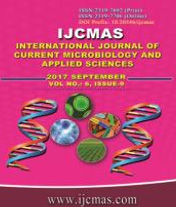


 National Academy of Agricultural Sciences (NAAS)
National Academy of Agricultural Sciences (NAAS)

|
PRINT ISSN : 2319-7692
Online ISSN : 2319-7706 Issues : 12 per year Publisher : Excellent Publishers Email : editorijcmas@gmail.com / submit@ijcmas.com Editor-in-chief: Dr.M.Prakash Index Copernicus ICV 2018: 95.39 NAAS RATING 2020: 5.38 |
The present investigation was under taken during rabi 2014-15 under rice fallow condition at District Seed Farm Kalyani, BCKV, W.B. Fifteen elite genotypes of chickpea (3 kabuli and 12 desi) were taken to evaluate and select the better yielding genotype(s) based on the nodulation behavior as well as root morphology, suitable for new alluvial zone of West Bengal and also to estimate the correlation among different underground and above ground agromorphic traits including yield. High GCV and PCV for nodule number per plant and seed yield per plant were estimated. High heritability with high GA% over mean was noticed in case of nodule number per plant, nodule dry weight per plant, number of pods per plant, 100 pod weight, 100 seed weight, harvest index and seed yield per plant. Correlation studies revealed that four characters viz., primary root number per plant, root length, root dry weight and shoot length were significantly positively correlated with yield (both at genotypic and phenotypic level). While, nodule dry weight per plant, number of pods per plant, 100 pod weight and harvest index were positively correlated with seed yield per plant at genotypic and phenotypic level. Path analysis exhibited that root dry weight, root length, shoot length, nodule dry weight, days to 50% flowering, plant height, number of secondary branches, number of pods per plant, number of seeds per pod and harvest index had direct positive effect on seed yield per plant. Among the desi types BG 256, Pusa 362, PDG 3, GNG 146 and CSJD 884 had more nodule dry weight per plant and seed yield per plant. Among kabuli types HK 1 and HK 2 had higher nodule weight but lower seed yield as compared to L 550. In case of majority of varieties, desi types had better nodulating behaviour including nodule number, nodule dry weight and better economic yield potential in contrast to kabuli types. Overall the variety BG 256 and Pusa 362 appeared to be very good performer at New Alluvial Zone.
 |
 |
 |
 |
 |